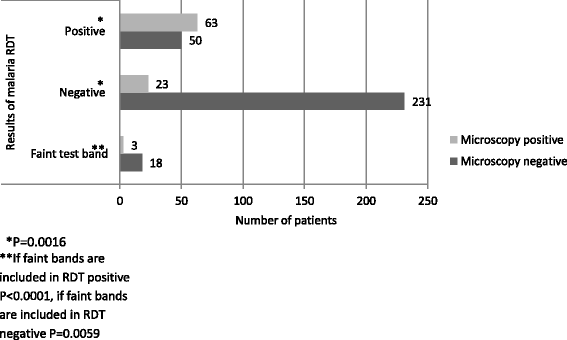The correlation between malaria RDT (Paracheck pf.®) faint test bands and microscopy in the diagnosis of malaria in Malawi
- PMID: 28464837
- PMCID: PMC5414284
- DOI: 10.1186/s12879-017-2413-x
The correlation between malaria RDT (Paracheck pf.®) faint test bands and microscopy in the diagnosis of malaria in Malawi
Abstract
Background: Faint test bands of Paracheck Pf.® are interpreted as malaria positive according to world health organization (WHO) guideline. However if there are conspicuous number of faint test bands, a performance of Paracheck Pf.® could be influenced depending on whether interpreting faint test bands as malaria positive or negative. Finding out the frequency and accurate interpretation of faint test bands are important to prevent the overdiagnosis and drug resistance.
Methods: A cross-sectional, descriptive study was conducted to find out the frequency of faint test bands and evaluate the performance of Paracheck Pf.® by sensitivity, specificity, positive predictive value (PPV), negative predictive value (NPV) and accuracy of diagnosis of Paracheck Pf.® using microscopy as the gold standard. 388 suspected patients with malaria in Malawi were recruited in this study. Malaria rapid diagnostic tests (RDTs) and microscopy were used and patients' information which includes age, sex, body temperature and signs or symptoms of malaria were recorded.
Results: Among all patients involved in the study, 29.1% (113/388) were found malaria positive by RDT. Overall 5.4% (21/388) of all Paracheck Pf.® tests resulted in a "faint test band" and 85.7% (18/21) corresponded with malaria negative by microscopy. Faint test bands which corresponded with malaria positive by microscopy were lower parasite density and there are no patients who showed definitive symptom of malaria, such as fever. When Paracheck Pf.® "faint test bands" were classified as positive, accuracy of diagnosis was 76.5% (95% CI 72%-80.7%) as compared to 80.4% (95% CI 76.1%-84.2%) when Paracheck Pf.® "faint test bands" were classified as negative.
Conclusions: This study shows that frequency of faint test bands is 5.4% in all malaria RDTs. The accuracy of diagnosis was improved when faint test bands were interpreted as malaria negative. However information and data obtained in this study may not be enough and more intensive research including a frequency and property of faint test bands is needed for significant interpretation of faint test bands.
Keywords: Accuracy of diagnosis; Faint test band; Malaria rapid diagnostic test; NPV; PPV; Paracheck pf.®; Sensitivity; Specificity.
Figures
Similar articles
-
Reducing malaria misdiagnosis: the importance of correctly interpreting Paracheck Pf® "faint test bands" in a low transmission area of Tanzania.BMC Infect Dis. 2011 Nov 3;11:308. doi: 10.1186/1471-2334-11-308. BMC Infect Dis. 2011. PMID: 22054069 Free PMC article.
-
Detecting Plasmodium falciparum in community surveys: a comparison of Paracheck Pf® Test and ICT Malaria Pf® Cassette Test to polymerase chain reaction in Mutasa District, Zimbabwe.Malar J. 2021 Jan 6;20(1):14. doi: 10.1186/s12936-020-03536-7. Malar J. 2021. PMID: 33407488 Free PMC article.
-
Assessment of two malaria rapid diagnostic tests in children under five years of age, with follow-up of false-positive pLDH test results, in a hyperendemic falciparum malaria area, Sierra Leone.Malar J. 2010 Jan 21;9:28. doi: 10.1186/1475-2875-9-28. Malar J. 2010. PMID: 20092620 Free PMC article.
-
Comparison of diagnostic performance between conventional and ultrasensitive rapid diagnostic tests for diagnosis of malaria: A systematic review and meta-analysis.PLoS One. 2022 Feb 10;17(2):e0263770. doi: 10.1371/journal.pone.0263770. eCollection 2022. PLoS One. 2022. PMID: 35143565 Free PMC article.
-
Can a non-invasive urine-based test become the next-generation diagnostic tool for malaria?Infez Med. 2018 Sep 1;26(3):199-203. Infez Med. 2018. PMID: 30246761 Review.
Cited by
-
Retrospective clinical performance evaluation of the Abbott Bioline HAT 2.0, a rapid diagnostic test for human African trypanosomiasis based on recombinant antigens.Trop Med Int Health. 2025 Feb;30(2):135-142. doi: 10.1111/tmi.14077. Epub 2024 Dec 23. Trop Med Int Health. 2025. PMID: 39716774 Free PMC article.
-
Malaria Rapid Diagnostic Tests: Literary Review and Recommendation for a Quality Assurance, Quality Control Algorithm.Diagnostics (Basel). 2021 Apr 25;11(5):768. doi: 10.3390/diagnostics11050768. Diagnostics (Basel). 2021. PMID: 33922917 Free PMC article. Review.
-
Combination of Serological, Antigen Detection, and DNA Data for Plasmodium falciparum Provides Robust Geospatial Estimates for Malaria Transmission in Haiti.Sci Rep. 2020 May 21;10(1):8443. doi: 10.1038/s41598-020-65419-w. Sci Rep. 2020. PMID: 32439948 Free PMC article.
-
False-negative malaria rapid diagnostic test results and their impact on community-based malaria surveys in sub-Saharan Africa.BMJ Glob Health. 2019 Jul 29;4(4):e001582. doi: 10.1136/bmjgh-2019-001582. eCollection 2019. BMJ Glob Health. 2019. PMID: 31406591 Free PMC article.
-
The Babesia observational antibody (BAOBAB) study: A cross-sectional evaluation of Babesia in two communities in Kilosa district, Tanzania.PLoS Negl Trop Dis. 2019 Aug 14;13(8):e0007632. doi: 10.1371/journal.pntd.0007632. eCollection 2019 Aug. PLoS Negl Trop Dis. 2019. PMID: 31412024 Free PMC article.
References
-
- Malawi Government Ministry of Health National Malaria Control Program. Malawi Malaria Indicator Survey, 2012. [https://dhsprogram.com/pubs/pdf/MIS13/MIS13.pdf] Accessed 15 December 2014.
-
- World Health Organization. World Malaria Report 2014. [http://www.who.int/malaria/publications/world_malaria_report_2014/en/] Accessed 21 December 2014.
-
- Foundation for Innovative New Diagnostics. Malaria Rapid Diagnostic Test: An implementation guide. [https://www.ghdonline.org/uploads/malaria_rdt_implementation_guide2013.pdf] Accessed 27 December 2014.
-
- United States Agency for International Development. President’s Malaria Operation Plan FY 2014.[https://www.pmi.gov/docs/default-source/default-document-library/malaria...] Accessed 18 January 2015.
MeSH terms
Substances
LinkOut - more resources
Full Text Sources
Other Literature Sources
Medical


